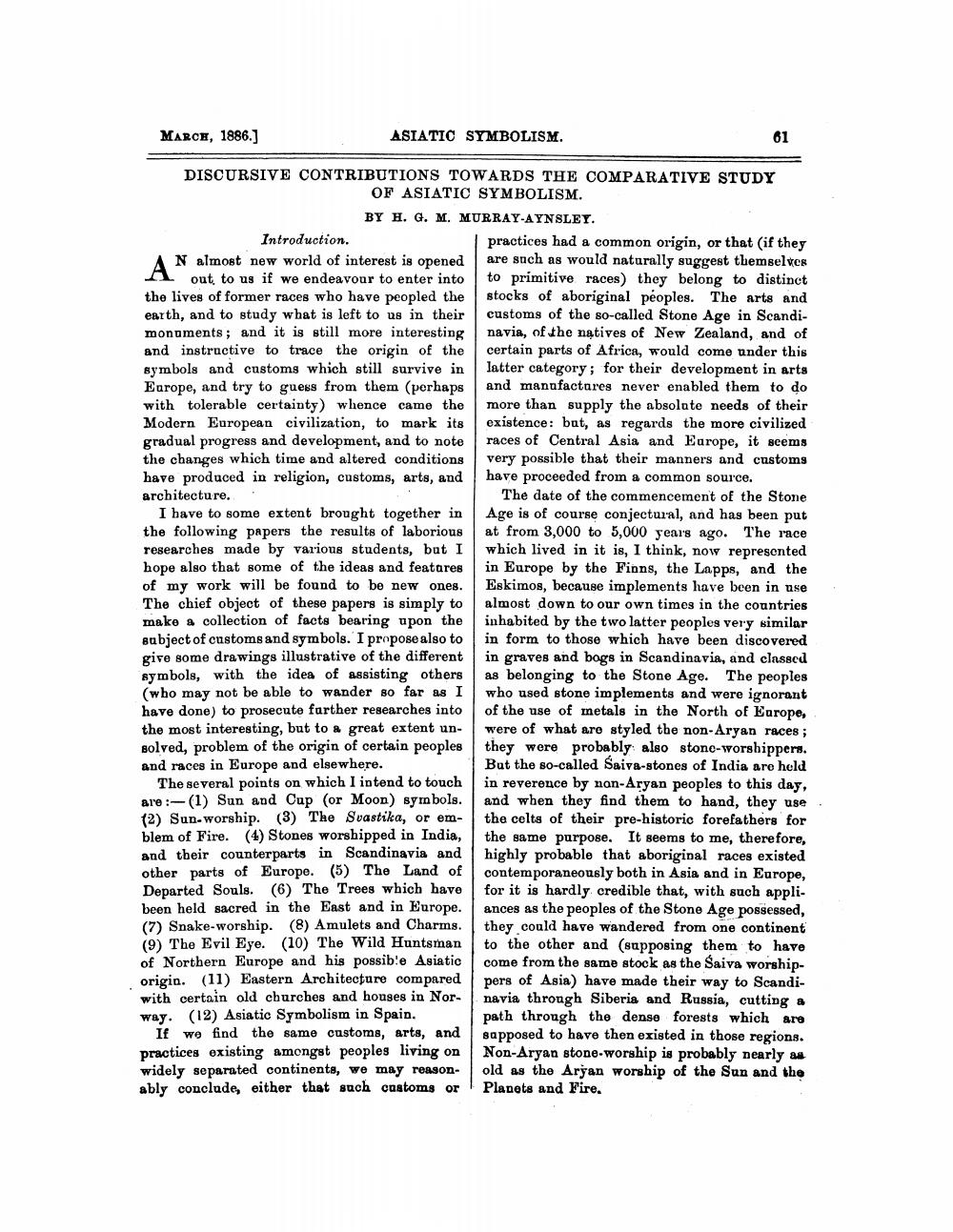________________
MARCE, 1886.]
ASIATIC SYMBOLISM.
DISCURSIVE CONTRIBUTIONS TOWARDS THE COMPARATIVE STUDY
OF ASIATIC SYMBOLISM.
BY H. G. M. MURRAY-AYNSLEY. Introduction.
practices had a common origin, or that (if they AN almost new world of interest is opened are such as would naturally suggest themselves A out to us if we endeavour to enter into to primitive races) they belong to distinct the lives of former races who have peopled the stocks of aboriginal peoples. The arts and earth, and to study what is left to us in their customs of the so-called Stone Age in Scandimonuments; and it is still more interesting navia, of the natives of New Zealand, and of and instructive to trace the origin of the certain parts of Africa, would come under this symbols and customs which still survive in latter category; for their development in arts Europe, and try to guess from them (perhaps and manufactares never enabled them to do with tolerable certainty) whence came the more than supply the absolute needs of their Modern European civilization, to mark its existence: bat, as regards the more civilized gradual progress and development, and to note races of Central Asia and Europe, it seems the changes which time and altered conditions very possible that their manners and customs have produced in religion, customs, arts, and have proceeded from a common source. architecture. .
The date of the commencement of the Stone I have to some extent brought together in Age is of course conjectural, and has been put the following papers the results of laborious at from 3,000 to 5,000 years ago. The race researches made by various students, but I which lived in it is, I think, now represented hope also that some of the ideas and features in Europe by the Finns, the Lapps, and the of my work will be found to be new ones. Eskimos, because implements have been in use The chief object of these papers is simply to almost down to our own times in the countries make a collection of facts bearing upon the inhabited by the two latter peoples very similar Bubject of customs and symbols. I propose also to in form to those which have been discovered give some drawings illustrative of the different in graves and bogs in Scandinavia, and classed symbols, with the idea of assisting others as belonging to the Stone Age. The peoples (who may not be able to wander so far as I who used stone implements and were ignorant have done) to prosecute further researches into of the use of metals in the North of Europe, the most interesting, but to a great extent un- were of what are styled the non-Aryan races ; Bolved, problem of the origin of certain peoples they were probably also stone-worshippers. and races in Europe and elsewhere.
But the so-called Saiva-stones of India are hold The several points on which I intend to touch in reverence by nan-Aryan peoples to this day, are :-(1) Sun and Cup (or Moon) symbols. and when they find them to hand, they use. (2) Sun-worship. (3) The Svastika, or em- the celts of their pre-historic forefathers for blem of Fire. (4) Stones worshipped in India, the same purpose. It seems to me, therefore, and their counterparts in Scandinavia and
highly probable that aboriginal races existed other parts of Europe. (5) The Land of
contemporaneously both in Asia and in Europe, Departed Souls. (6) The Trees which have for it is hardly credible that, with such applibeen held sacred in the East and in Europe. ances as the peoples of the Stone Age possessed, (7) Snake-worship. (8) Amulets and Charms. they could have wandered from one continent (9) The Evil Eye. (10) The Wild Huntsman | to the other and (supposing them to have of Northern Europe and his possible Asiatic come from the same stock as the Saiva worshiporigin. (11) Eastern Architecture compared pers of Asia) have made their way to Scandiwith certain old churches and houses in Nor- navia through Siberia and Russia, cutting a way. (12) Asiatic Symbolism in Spain.
path through the dense forests which are If we find the same customs, arts, and sapposed to have then existed in those regions. practices existing amongst people living on Non-Aryan stone-worship is probably nearly as widely separated continents, we may reason old as the Arjan worship of the Sun and the ably conclude, either that such customs or Planets and Fire.




